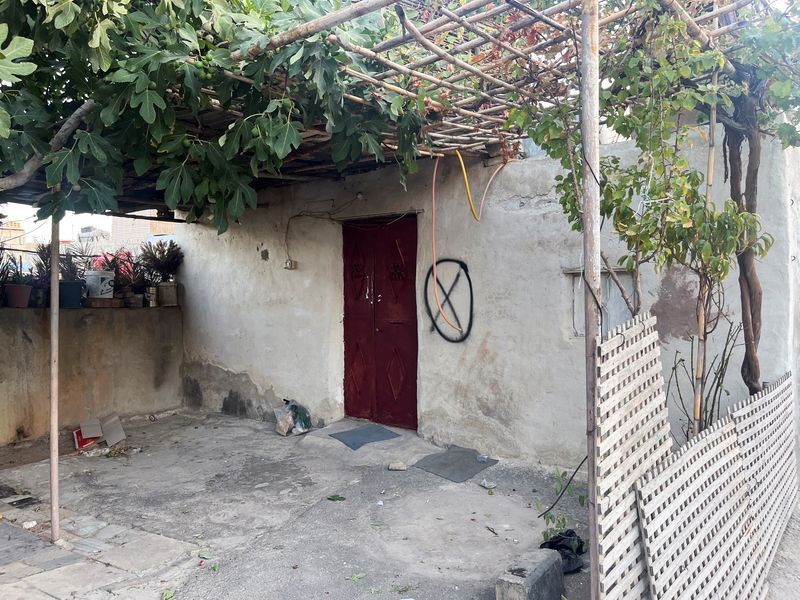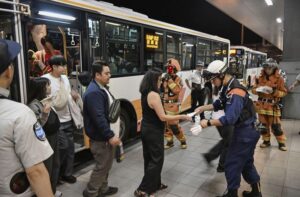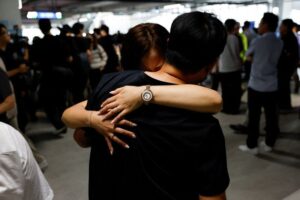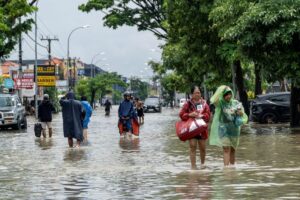
AL-SOMARIA, Syria (Reuters) -Syrian security forces stormed the rundown Damascus suburb in late August, toting guns, swords and eviction orders. In their wake, they left the district’s homes spray-painted with big black “X”s and “O”s: marking who could stay and who must go.
The raids targeted al-Somaria, home to the families of thousands of former soldiers in the army of Bashar al-Assad, whose toppling by rebels nine months ago unleashed a wave of violence against the minority Alawite group to which he belongs.
The district is entangled in the toxic legacy of the Assad dynasty which ruled Syria for more than five decades, crushing opposition from the majority Sunni Muslim population while handing top jobs and seized land to Alawite loyalists.
On August 27-29, scores of security forces led by an interior ministry commander known as Abu Hudhayfah went door-to-door, telling families they were living on land illegally seized by the Assads and demanding proof they owned their homes, according to a dozen residents and two local leaders who all said they experienced this treatment.
Those families who couldn’t immediately produce ownership documents saw the outer walls of their homes spray-painted with “O”s and affixed with printed eviction orders, the locals told Reuters in the final days of August, providing the most detailed accounts yet of the raids and the forces behind them.
“This is a notification to residents of illegal housing in al-Somaria to leave their houses in no more than 48 hours or face punishment under the law,” read the notices which Reuters saw displayed on dozens of homes. The documents stated they had been issued by the “Public Housing Committee of the General Secretariat of the Presidency of the Republic”.
Many dwellings were marked with “X”s, indicating they were safe, while others had both “X”s and “O”s, sprayed on by different groups of security forces over the course of the raids, the residents and local leaders said. Some homes with “X”s or with both signs also had eviction notices.
Dozens of male residents were interrogated about whether they had served in Assad’s army, the people interviewed said. Others were detained in a residential building that had been turned into a police station and were beaten there by the armed fighters, according to four residents including three victims.
“I’m a lawyer and working towards my doctorate and even I got slapped around,” said Ali Barakat, a member of al-Somaria’s neighbourhood committee, which acts like a town council and represents residents in meetings with the government.
“I’ve been living in my house for 40 years. My father bought it with his blood, sweat and tears so he could pass it on to me. I won’t give it up.”
Syria’s information and interior ministries didn’t respond to requests for comment on the eviction actions in al-Somaria, including what triggered the raids and whether they were authorized by the government. Reuters couldn’t find any previous record of the Housing Committee cited in the notices.
The interior ministry commander, Abu Hudhayfah, didn’t respond to Reuters phone calls on August 29. On September 2, he responded to a text message asking if he was still in al-Somaria by saying, “No.” He did not respond to further questions.
A Reuters journalist who visited al-Somaria on September 11 and was told by residents that Abu Hudhayfah was now stationed in the building that had been turned into a police station. His staff there said he was not accepting interview requests.
Before the eviction raids, the almost entirely Alawite district of al-Somaria was home to about 22,000 people, nearly half of them families of former Assad soldiers, according to Barakat and a fellow member of the neighbourhood committee.
A week later, around 3,000 people remained, they said.
Reuters couldn’t independently verify the committee’s figures. A reporter who visited the area on September 3 and 11 saw a virtual ghost town, with no lights in homes, no cars on roads, and a handful of people in the streets.
On September 11, Reuters saw security forces guarding the main entrance to al-Somaria and restricting access to the area.
Reuters couldn’t establish if any residents were physically evicted from homes. All the people interviewed said the raids created a general sense of panic that led to most families fleeing in the ensuing days, fearing the kind of violence seen in coastal areas this year when armed groups affiliated to the new government turned on Alawite civilians, killing hundreds of people.
AL-SOMARIA SEIZED BY ASSADS IN 1970S
Members of the Assad clan, including Bashar, evicted Sunni residents from several suburbs of the capital and built housing to distribute to soldiers and their families, much of it cheap and poorly constructed one-storey homes. These districts formed an Alawite belt that protected the seat of power.
Al-Somaria itself was appropriated in the 1970s by Rifaat al-Assad, a powerful Syrian security official and brother of then-President Hafez al-Assad, Bashar’s father. Rifaat renamed the area, previously known as al-Balan, after his son: Somar.
During the eviction raids last month, two residents said that they had produced ownership documents, but that Abu Hudhayfah had dismissed the papers, telling them they dated back to the Assad era and were therefore considered invalid.
They received “O”s on their homes.
In a public statement on September 3, Damascus Governor Maher Marwan said that “what happened in al-Somaria was the result of the accumulation of problems of unjust expropriation and real estate corruption over decades of rule of the ousted regime.”
He said the new Syrian government was committed to resolving these issues fairly and transparently, without forced evictions. Legal committees would be formed to “review the expropriation of al-Somaria and the subsequent informal housing that have persisted for decades”, he added, without elaborating.
Marwan didn’t respond to a request for comment.
Miloon Kothari, an independent expert on human rights and social policy, and the first UN Special Rapporteur on adequate housing, described the raids in al-Somaria last month as a “succession of violations starting from the displacement to the fact that the community is now scattered and some are homeless”.
“Forced evictions are a gross violation of human rights,” he told Reuters. “If the government in Syria is serious about complying with international human rights standards, then they are responsible for the violation of the rights of these people. This is a clear position at the international level.”
MAJOR METRO PROJECT IN AL-SOMARIA
The sudden downfall of Assad in December last year saw the ascendancy of a new government led by former members of Hayat Tahrir al-Sham (HTS), the most powerful of the Sunni Islamist rebel groups that had fought the Alawite president during 14 years of civil war that devastated the country.
The fledgling administration has strived to integrate dozens of the rebel factions into its security forces, including some foreign fighters. It has struggled to fill a security vacuum left after the collapse of Assad’s defence apparatus and Syria has been plagued by bouts of sectarian bloodletting with armed groups affiliated to the government killing hundreds of civilians from the Alawite and Druze communities.
The evictions in al-Somaria are also emblematic of one of the thorniest dilemmas for Syria’s new rulers: how to address the legacy of property expropriation and reallocation by the Assad family that long exacerbated communal tensions.
Other Alawite districts, including Mazzeh 86 and al-Wuroud, were also bestowed on Assad loyalists at the expense of former residents over past decades.
The challenge of untangling property rights has taken on renewed urgency as Syria aims to implement several large infrastructure developments around Damascus, including a $2 billion scheme to announced by the government in early August establish a metro line. That project would include a transfer junction in al-Somaria, complete with a parking garage for hundreds of cars, according to state news agency SANA.
Any future property developments should take sectarian sensitivities into account, said Moatasem al-Sioufi, executive director of The Day After, a Syrian non-profit working to support a democratic transition in Syria.
“A nationwide urban planning solution is needed that takes into account the issue of informal settlements,” he said. “However, any solution must certainly not involve eviction from their homes in this manner.”
Al-Somaria was long farmed by residents of Moadhamiyet al-Sham, an adjacent Sunni suburb of Damascus. Now, with the Assads gone, some want the district back.
Mohammed al-Wawi, a 54-year-old cleaning supplies store owner in Moadhamiyet al-Sham, said his family had owned a small patch of land in the west of al-Somaria.
“We gave up on reclaiming it years ago,” he added. “Who would have thought the regime would fall like this?”
(Reporting by Feras Dalatey; Additional reporting By Maggie Michael; Editing by Maya Gebeily and Pravin Char)






